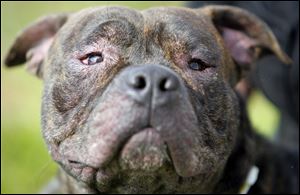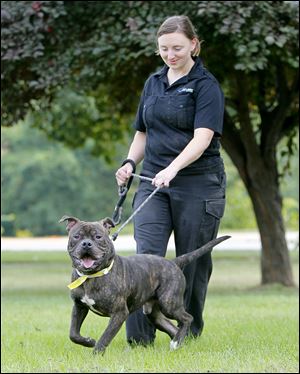
CRITTER CARE
DeNiro will eventually get surgery he needs to treat eyelid abnormality
9/23/2013
DeNiro, one of the latest beneficiaries of Cutie’s Fund, suffers from entropion, a genetic condition in which the eyelid ‘rolls’ inward.
The Blade/Andy Morrison
Buy This Image

DeNiro, one of the latest beneficiaries of Cutie’s Fund, suffers from entropion, a genetic condition in which the eyelid ‘rolls’ inward.
DeNiro, a brindle “pit bull,” isn’t the same dog he was when he arrived at the Lucas County Dog Warden’s Office more than a month ago.
The 65-pound dog was brought in by the Toledo Police Department after hours on Aug. 19 after he was found on Hartman Street near East Central Avenue.
He has received antibiotics for an upper respiratory infection, Benadryl for skin itchiness, Cephalexin for skin infection, Ketaconozole for skin issues, and Otomax for ear infections.
Despite all the ailments, DeNiro is a very friendly boy that likes attention, said Lucas County Dog Warden Julie Lyle.
His biggest problem is squinty eyes.
But the squinting isn’t because of a need for sunglasses. The friendly dog suffers from entropion, an abnormality of the eyelids in which the eyelid “rolls” inward.
This inward rolling often causes the hair on the surface of the eyelid to rub against the cornea (outer part of the eyeball) resulting in pain, corneal ulcers, or corneal erosions. This corneal damage can also result in corneal scarring, that can interfere with vision.
As a result of the condition, he received an eye ointment with a steroid in it the whole time he was at the pound.
With the help of the dog warden’s Cutie’s Fund for special medical needs, he will eventually get the surgery he needs at West Suburban Animal Hospital in Sylvania Township.

Laura Simmons, operations manager at the Lucas County Dog Warden's Office, takes DeNiro for a walk. The dog was found by police more than a month ago.
He was transferred there on Wednesday, but the veterinarians were unable to do the surgery because of too much swelling around the eye, said Dr. Gary Thompson. The vet will re-evaluate him in a couple of weeks.
“The dog has a terrible skin infection, which may be exacerbating the problem,” Dr. Thompson said.
In the meantime, the Lucas County Pit Crew is going to provide him with a temporary home.
“He is a good candidate for transfer as he is a nice boy who did well on his behavior evaluation, but has special medical needs that are not best treated in a shelter environment,” Ms. Lyle said. “Typically these dogs post-surgery need to wear an e-collar for a period of time, which is very difficult to maneuver within a kennel, and they need to be in a clean and dry environment to promote healing.”
The foster home will take care of him after he has the surgery, said Jean Keating, founder and president of the Lucas County Pit Crew.
In certain breeds, the condition is very common, Dr. Thompson said. Those include bulldogs, Shar Peis, and other “wrinkly faced” dogs.
Surgery is fairly straight forward.
“You remove the extra skin on the affected eyelid to roll out the lid margin,” Dr. Thompson said.
Specialists can charge as much as $2,000 for the surgery. At a general practice, it depends on the experience of the surgeon and usually ranges from about $500 to $1,000
Surgery is the only way to correct the problem.
“Surgery is indicated if the eyelashes, hairs are rubbing the eye, causing pain or damaging the eye,” Dr. Thompson said.
The condition is more common in dogs, but it can also occur in cats, he said.

In toy breeds of dogs, excess tears and inner-eye inflammation are common signs of entropion, according to PetMD.com. However, in giant breeds, it is more common to see mucus and/or pus discharge from the outer corner of the eyes. In other breeds of dogs, eye tics, discharge of pus, eye inflammation, or even rupture of the cornea are the usual signs of entropion.
Facial shape is the primary genetic cause of entropion. In short-nosed breeds of dogs, there is more tension on the ligaments of the inner eye than would normally be seen. This, along with the shape of their nose and face, can lead to both the top and bottom eyelids rolling inward toward the eyeball, according to PetMD.
Giant breeds have the opposite problem. They tend to have excess slack in the ligaments around the outer corners of their eyes. This permits the outer edges of the eyelids to fold inward.
Repeated bouts of eye infections also can cause spastic entropion, which can lead to functional entropion. This can also be caused by other types of eye irritants and is generally the case in breeds that do not normally exhibit entropion. Lastly, inflammation of the chewing muscles or severe weight loss can lead to loss of fat and muscle around the eye socket, which may be another cause for entropion, according to PetMD.com
Contact Tanya Irwin at tirwin@theblade.com, 419-724-6066, or on Twitter@TanyaIrwin.